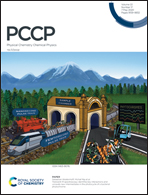Phosphorylation-dependent conformational changes of arrestin in the rhodopsin–arrestin complex†
Abstract
G protein-coupled receptors (GPCRs) are membrane proteins that play critical roles in transmembrane signaling. Intracellular arrestin can form a complex with GPCRs to block G protein binding or mediate independent signaling pathways. It is known that different extracellular stimuli lead to the recruitment of different downstream effectors through arrestin. How this selective signaling is achieved is a fascinating but unresolved question. One hypothesis is that different stimuli can lead to different phosphorylation patterns in the C-terminus loop of GPCR (C-loop), and arrestin then adopts different conformations according to the phosphorylation pattern, and then arrestin in turn can recruit various downstream signaling molecules. In this study, we conducted atomistic molecular dynamics (MD) simulations to investigate whether the conformation of arrestin is related to the phosphorylation pattern of the GPCR C-loop in the GPCR–arrestin complex. Our results showed that arrestin undergoes a significant conformational change when binding to the GPCR C-loop, and its specific holo conformation seems to be phosphorylation-dependent. Further analysis of the pairwise forces between the phosphorylated residues of the C-loop and the adjacent residues of arrestin showed that these forces vary to a large degree, depending on the phosphorylation pattern of the C-loop, which might direct arrestin into distinct conformations and result in the selective binding of downstream signaling molecules. These results shed light on the C-loop phosphorylation pattern dependent signaling through the GPCR–arrestin pathway.



 Please wait while we load your content...
Please wait while we load your content...